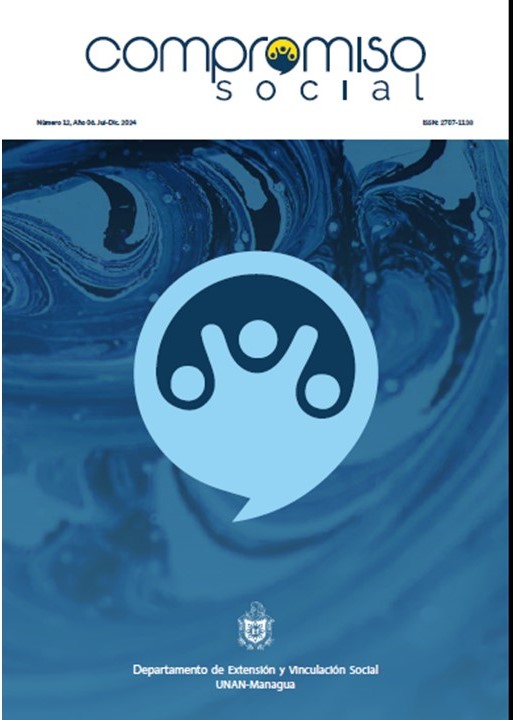Beekeeping as an element of cultural resilience in the Río Coco UNESCO Global Geopark
DOI:
https://doi.org/10.5377/recoso.v7i12.19645Keywords:
Beekeeping, geopark río coco, cultural identity, territorial development, heritageAbstract
The objective of the study was to analyze the perception and knowledge of professionals and beekeepers living in the UNESCO Río Coco Global Geopark. The methodology used was mixed, descriptive, cross-sectional, participatory and inclusive. A semi-structured interview and a virtual survey were applied. As a result, it was found that 68% of beekeepers surveyed are women, highlighting the success of programs that promote their active participation in beekeeping as agents of change. Seventy-five percent of the beekeepers consider that beekeeping not only generates economic income, but also promotes tourism and cultural identity, especially in indigenous Chorotega communities. Although 88% of beekeepers feel that they are part of the Geopark, there are gaps in the integration of beekeeping into tourism circuits, which limits its development and sustainability potential. In conclusion, beekeeping and its products and services should be part of tourist circuits and packages promoted from the territorial platform. In addition, a more substantial economic investment is required to promote the development of the beekeeping sector. Beekeeping must be institutionalized and recognized as an integral part of the routes and geosites that make up the geopark, and beekeeping products and byproducts must be valued, labeled with the GEO brand, and recognized as heritage gastronomic products through the promotion of the agro-productive and cultural chain of honey and its derivatives.
961
References
Castillo, F. (2021). El patrimonio geológico al servicio del patrimonio: Geoturismo en la cuenca carbonífera Concepción Arauco Chile.Barcelona: Universidad Autónoma de Barcelona. https://www.tdx.cat/handle/10803/674385?locale-attribute=en
Dietsch, L. (2011). La apicultura: ¿Una alternativa de desarrollo rural sostenible para las laderas secas de Nicaragua? Encuentro (89), 11. https://doi.org/10.5377/encuentro.v44i89.550
Espinoza, R. H. (2021). Geoturismo como estrategia de desarrollo territorial en los distritos de Aquia y Huallanca. Lima, Peru. https://www.academia.edu/24648574/GEOTURISMO_COMO_ESTRATEGIA_
DE_DESARROLLO_TERRITORIAL_EN_LOS_DISTRITOS_AQUIA_Y_HUALLANCA_ANCASH
Gobierno de Nicaragua. (2006). LEY N°. 605: Ley que declara Área Protegida en la Categoría de Monumento Nacional al “Cañón De Somoto. Managua, Nicaragua: Asamblea Nacional de Nicaragua. http://legislacion.asamblea.gob.ni/normaweb.nsf/3133c0d121ea3897062568a1005e0f89/
c455d6fc8b19e4c20625755b0077e4c7?OpenDocument.
Hernández, L., y Povedano, E. (2023). Asignatura pendiente de la co gestión en el geoturismo: Análisis del Geoparque Global de El Hierro. PASOS Revista de turismo y patrimonio cultural, 21(1), 41.https://dialnet.unirioja.es/servlet/articulo?codigo=8749812
Hernández, R., Fernández, C., y Bautista, P. (2014). Metodología de la Investigación. México DF: McGraw-Hill. https://apiperiodico.jalisco.gob.mx/api/sites/periodicooficial.jalisco.gob.mx/files/metodologia_de_la_investigacion_-_roberto_hernandez_sampieri.pdf
Infante, J. R. (2022). Desarrollo Económico Territorial: Modelo de cogestión para el turismo sostenible y el desarrollo local en el Valle del Colca y Valle los Volcanes de Andagua; región Arequipa. 2015 a 2017. Lima: Pontificia Universidad Católica de Perú. https://tesis.pucp.edu.pe/repositorio/handle/20.500.12404/21477
Javaloy, F. (1993). El paradigma de la identidad social en el estudio del comportamiento colectivo y de los movimientos sociales. Psicothema, 5(1), 277-286. https://dialnet.unirioja.es/servlet/articulo?codigo=2018620
Juventud Presidente [JP]. (24 de enero de 2021). Geoparque Río Coco: El origen del planeta. (JP, Ed.) Somoto, Madriz, Nicaragua. https://www.youtube.com/watch?v=Au2c0yDlce4
Mayorga, D., Luna, J., y Romero, K. (2020). Apicultura en el occidente de Nicaragua: la experiencia de los productores rurales del municipio El Viejo. Economía y sociedad, 1(2), 49-58. https://doi.org/10.5377/aes.v1i2.11446
METEO BLUE. (s.f). Datos climáticos y meteorológicos históricos del departamento de Madriz. Mateoblue: https://www.meteoblue.com/es/tiempo/historyclimate/climatemodelled/departamento-de-madriz_nicaragua_3617796#:~:text=Departamento%20de%20Madriz%2C%20Nicaragua%2C,13.5%C2%B0N%2086.42%C2%B0O%2C%20679m%20s.n.m.%2022%E2%80%89%C2%B0C
Nolasco, N. L. (2017). Estudio sobre situación real de la apicultura y su adaptación ante el cambio climático en la zona de Las Segovias de Nicaragua. Amigos de la Tierra, Madriz. Somoto: Amigos de la Tierra. https://inprhusomoto.org/wp-content/uploads/2020/02/ESTUDIO-APICULTURA-Y-CAMBIOCLIM%C3%81TICO-LAS-SEGOVIAS-2017.pdf
Nuñez, L., Sanabria, B., y Suarez, C. (2020). Geoturismo: aprovechamiento turístico del potencial geológico en las veredas de San Benito y San Eugenio, en el municipio de Sibaté. Turismo y Sociedad (27), 187–215. https://doi.org/10.18601/01207555.n27 .11.
Organización de las Naciones Unidas para la Educación, la Ciencia y la Cultura [UNESCO]. (2023). Textos fundamentales para la salvaguarda del patrimonio cultural inmaterial de 2023. Paris: UNESCO. https://www.patrimoniocultural.gob.ec/wp-content/uploads/2023/03/23_GuiametodologicaparalasalvaguardiaPCI.pdf
Palacio, J., Sánchez, J., y Schilling, M. (2016). Patrimonio geológico y su conservación en America Latina. México: Instituto de geografía UNAM. http://www.publicaciones.igg.unam.mx/index.php/ig/catalog/book/77
Paskova, M. (2014). Río Coco (Nicaragua) Propuesta de Geoparque. República Checa.
Paskova, M. (2018). Can Indigenous Knowledge Contribute to the Sustainability Management of the Aspiring Río Coco Geopark, Nicaragua? Republica Checa: MDPI.
Pita, A., Santos, V., y Choez, M. (2023). Percepción ciudadana sobre el patrimonio cultural gastronómico en la gestión turística en Jipijapa. Turismo y patrimonio (20), 31-46. https://doi.org/10.24265/turpatrim.2023.n20.02
Sanchez, N. J. (2019). Estudio de la cadena de valor de la miel de abeja (apis mellifera), en el departamento de Madriz, Nicaragua. Somoto, Madriz: Universidad Internacional Iberoamericana.
UNAN-Managua. (2016). Geología del Geoparque Río Coco. Managua: IGGCIGEO-UNAN-Managua. https://igg.unan.edu.ni/index.php/2023/07/17/geoparque-rio-coco-2/
UNAN-Managua. (2021). Geología del Geoparque Río Coco II edición. Managua: IGG-CIGEO-UNAN-Managua.
UNESCO. (2017). Los geoparques mundiales de la UNESCO. Paris: UNESCO.
UNESCO. (30 de julio de 2020). Río Coco, el primer Geoparque Mundial de la UNESCO en Centroamérica. UNESCO: https://www.unesco.org/es/articles/rio-coco-el-primer-geoparque-mundial-de-la-unesco-en-centroamerica




